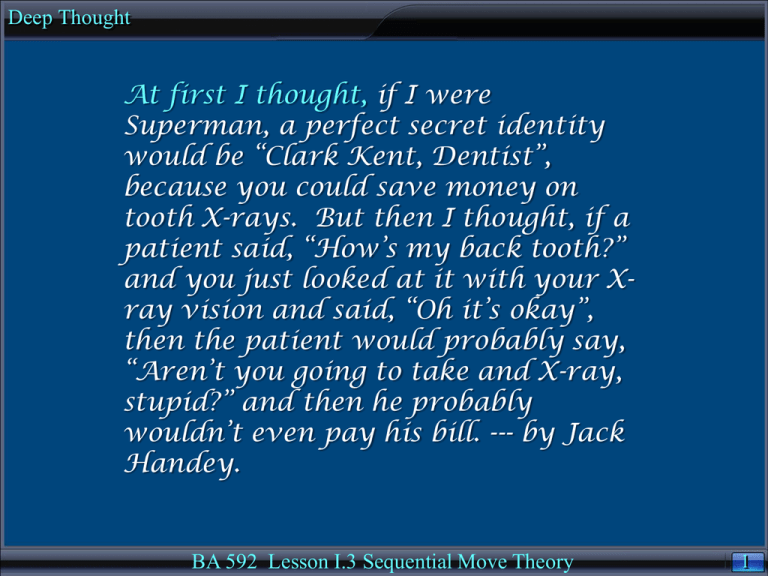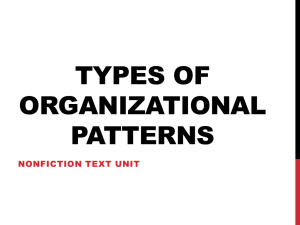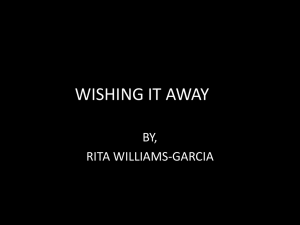Game Theory
advertisement

Deep Thought At first I thought, if I were Superman, a perfect secret identity would be “Clark Kent, Dentist”, because you could save money on tooth X-rays. But then I thought, if a patient said, “How’s my back tooth?” and you just looked at it with your Xray vision and said, “Oh it’s okay”, then the patient would probably say, “Aren’t you going to take and X-ray, stupid?” and then he probably wouldn’t even pay his bill. --- by Jack Handey. BA 592 Lesson I.3 Sequential Move Theory 1 Lesson overview Chapter 3 Games with Sequential Moves Lesson I.3 Sequential Move Theory Each Example Game Introduces some Game Theory • Example 1: A Rollback Solution • Example 2: A Game Tree • Example 3: Off the Equilibrium Path • Example 4: Multiple Equilibria • Example 5: Jealous Humans • Example 6: Simple Humans Lesson I.4 Sequential Move Applications BA 592 Lesson I.3 Sequential Move Theory 2 Example 1: A Rollback Solution • Sequential moves are strategies where there is a strict order of play. • Perfect information implies that players know everything that has happened prior to making a decision. • Complex sequential move games are most easily represented in extensive form, using a game tree. • Chess is a sequential-move game with perfect information. BA 592 Lesson I.3 Sequential Move Theory 3 Example 1: A Rollback Solution Backward induction or rollback solves sequential move games with perfect information by rolling back optimal strategies from the end of the game to the beginning. BA 592 Lesson I.3 Sequential Move Theory 4 Example 1: A Rollback Solution Century Mark Game • Played by pairs of players taking turns. • At each turn, each player chooses a number between 1 and 10 inclusive. • This choice is added to sum of all previous choices (the initial sum is 0). • The first player to take the cumulative sum to 100 or more wins. How should you play the game as first player? Start at the end. What number gets you to 100 next turn? BA 592 Lesson I.3 Sequential Move Theory 5 Example 1: A Rollback Solution Rollback Solution • If you bring the cumulative sum to 89, you can take the cumulative sum to 100 and win no matter what your opponent does. (Whatever your opponent does you can make the sum of your two moves equal 11.) • Hence, if you bring the cumulative sum to 78, you can bring the cumulative sum to 89 on your next turn (and so eventually win) no matter what your opponent does. • And so on for sums 67, 56, 45, 34, 23, 12. • Hence, if you play 1 first, you can bring the cumulative sum to 12 on your next turn (and so eventually win) no matter what your opponent does. • That is a strategy --- a complete plan of actions no matter what your opponent does. BA 592 Lesson I.3 Sequential Move Theory 6 Example 2: A Game Tree Game trees or extensive forms consist of nodes and branches. Nodes are connected to one another by the branches, and come in two types. Some nodes are decision nodes, where a player chooses an action. In some games, Nature is a “player”; Nature can decide whether it rains or snows. The other nodes are terminal nodes, where players receive the outcomes of the actions taken by themselves and all other players. BA 592 Lesson I.3 Sequential Move Theory 7 Example 2: A Game Tree Emily, Nina, and Talia all live on the same street. Each has been asked to contribute to a flower garden. The quality of the garden increases with the number of contributions, but each lady also prefers to not contribute. Specifically, suppose each lady gains 2 dollars worth of happiness from each of the first two contributions to the garden (including her own contribution, if any) and 0.50 dollars worth from a third contribution, but then looses 1 dollar if she herself contributes. Define the game tree for this Street Garden Game, then find the rollback solution. Should Emily contribute? BA 592 Lesson I.3 Sequential Move Theory 8 Example 2: A Game Tree Street Garden Game Emily Contribute Don't Nina Nina Contribute Don't Contribute Don't Talia Talia Talia Talia Cont. Don't Cont. Don't Cont. Don't Cont. Don't 3.5,3.5,3.5 3,3,4 3,4,3 1,2,2 4,3,3 2,1,2 2,2,1 0,0,0 BA 592 Lesson I.3 Sequential Move Theory 9 Example 2: A Game Tree Rolling from the end: Talia’s Strategy. (Non-optimal strategies are blacked out.) Emily Contribute Don't Nina Nina Contribute Don't Contribute Don't Talia Talia Talia Talia Cont. Don't Cont. Don't Cont. Don't Cont. Don't 3.5,3.5,3.5 3,3,4 3,4,3 1,2,2 4,3,3 2,1,2 2,2,1 0,0,0 BA 592 Lesson I.3 Sequential Move Theory 10 Example 2: A Game Tree Rolling back one from the end: Nina’s Strategy Emily Contribute Don't Nina Nina Contribute Don't Contribute Don't Talia Talia Talia Talia Cont. Don't Cont. Don't Cont. Don't Cont. Don't 3.5,3.5,3.5 3,3,4 3,4,3 1,2,2 4,3,3 2,1,2 2,2,1 0,0,0 BA 592 Lesson I.3 Sequential Move Theory 11 Example 2: A Game Tree Rolling back to the beginning: Emily’s Strategy, which completes the rollback solution. Emily Contribute Don't Nina Nina Contribute Don't Contribute Don't Talia Talia Talia Talia Cont. Don't Cont. Don't Cont. Don't Cont. Don't 3.5,3.5,3.5 3,3,4 3,4,3 1,2,2 4,3,3 2,1,2 2,2,1 0,0,0 BA 592 Lesson I.3 Sequential Move Theory 12 Example 3: Off the Equilibrium Path Beliefs about strategy off the equilibrium path (strategies that are never acted on) are important to keep players on the equilibrium path. Just as your belief that shooting a gun at your own head will kill you makes you decide to never shoot a gun at your own head. BA 592 Lesson I.3 Sequential Move Theory 13 Example 3: Off the Equilibrium Path Street Garden Game: alternative payoffs Emily Contribute Don't Nina Nina Contribute Don't Contribute Don't Talia Talia Talia Talia Cont. Don't Cont. Don't Cont. Don't Cont. Don't 5,5,5 3,3,6 3,4,3 1,2,2 4,3,3 2,1,2 2,2,1 2,2,2 BA 592 Lesson I.3 Sequential Move Theory 14 Example 3: Off the Equilibrium Path Street Garden Game: Equilibrium Path Emily Contribute Don't Nina Nina Contribute Don't Contribute Don't Talia Talia Talia Talia Cont. Don't Cont. Don't Cont. Don't Cont. Don't 5,5,5 3,3,6 3,4,3 1,2,2 4,3,3 2,1,2 2,2,1 2,2,2 BA 592 Lesson I.3 Sequential Move Theory 15 Example 3: Off the Equilibrium Path Emily believes that, if she contributed, then Nina would not contribute but Talia would contribute. But if, instead, Emily believed that, if she contributed, then Nina and Talia would both contribute, then Emily believes contributing gives her payoff 5, which is more than her payoff on the equilibrium path. Emily Contribute Don't Nina Nina Contribute Don't Contribute Don't Talia Talia Talia Talia Cont. Don't Cont. Don't Cont. Don't Cont. Don't 5,5,5 3,3,6 3,4,3 1,2,2 4,3,3 2,1,2 2,2,1 2,2,2 BA 592 Lesson I.3 Sequential Move Theory 16 Example 4: Multiple Equilibria Rollback equilibria are unique unless a player gets equal payoffs from two or more different actions. One method to restore a unique equilibrium (to be used as a prescription or prediction) is to question whether a game with equal payoffs is somehow exceptional or avoidable. BA 592 Lesson I.3 Sequential Move Theory 17 Example 4: Multiple Equilibria Employees know there is a positive gain to their continued employment, and that gain is split with their employer according to the employees wages. Suppose Employee A generates 100 dollars of gain by remaining employed with Employer B. Employee A is considering increasing his wage demands to one of three levels. Those three levels give him either 100%, or 90%, or 50% of the 100 dollars of gain. Which wage should the employee demand? Define the game tree for this Bargaining Game, then find all the rollback equilibria. BA 592 Lesson I.3 Sequential Move Theory 18 Example 4: Multiple Equilibria Bargaining Game: Game Tree Proposer I take 100% I take 90% I take 50% Responder Responder Responder Accept Reject Accept Reject Accept Reject 100,0 0,0 90,10 0,0 50,50 0,0 BA 592 Lesson I.3 Sequential Move Theory 19 Example 4: Multiple Equilibria Bargaining Game: Proposer Partial Rollback Solution I take 100% I take 90% I take 50% Responder Responder Responder Accept Reject Accept Reject Accept Reject 100,0 0,0 90,10 0,0 50,50 0,0 BA 592 Lesson I.3 Sequential Move Theory 20 Example 4: Multiple Equilibria Rollback analysis was incomplete in that game because the responder got equal payoffs from two different actions. But that is only because the Proposer demanded 100%. What if the Proposer demands 99.99%? Now there is a unique rollback solution with payoffs almost as high as if a demand of 100% were accepted. BA 592 Lesson I.3 Sequential Move Theory 21 Example 4: Multiple Equilibria Bargaining Game: Complete Rollback Solution Proposer I take 99.99% I take 90% I take 50% Responder Responder Responder Accept Reject Accept Reject Accept Reject 99.99,0.01 0,0 90,10 0,0 50,50 0,0 BA 592 Lesson I.3 Sequential Move Theory 22 Example 5: Jealous Humans Humans in some sequential move games do not follow the rollback solution because that solution may be felt to be too unfair. Economic policymakers thus favor public policies whose rollback solutions seem fair enough for humans to accept. And businesspeople thus adapt strategies depending on whether they are playing against jealous humans (perhaps some of their customers) or rational players (other businesspeople). BA 592 Lesson I.3 Sequential Move Theory 23 Example 5: Jealous Humans Shoppers know there is a positive gain to making purchases, and that gain is split with sellers according to the purchase price. Shopper A generates 100 dollars of gain by buying from Seller B. Buyer A is considering three alternative price offers. Those three offers give him either 99%, or 90%, or 50% of the 100 dollars of gain. Which price should Buyer A offer? Define the game tree for this Bargaining Game, then find the rollback solution. . BA 592 Lesson I.3 Sequential Move Theory 24 Example 5: Jealous Humans Bargaining Game: Game Tree Proposer I take 99% I take 90% I take 50% Responder Responder Responder Accept Reject Accept Reject Accept Reject 99,1 0,0 90,10 0,0 50,50 0,0 BA 592 Lesson I.3 Sequential Move Theory 25 Example 5: Jealous Humans Bargaining Game: Rollback Solution Proposer I take 99% I take 90% I take 50% Responder Responder Responder Accept Reject Accept Reject Accept Reject 99,1 0,0 90,10 0,0 50,50 0,0 BA 592 Lesson I.3 Sequential Move Theory 26 Example 5: Jealous Humans Which price should the shopper offer? In the rollback solution, the shopper should offer the price that gives him 99% of the gain from trade. But humans like the seller might not follow the rollback solution because that solution is too unfair. Rather, the shopper may have to offer a price that gives him only 90% or 50% of the gain from trade. BA 592 Lesson I.3 Sequential Move Theory 27 Example 6: Simple Humans Humans in some sequential move games do not follow the rollback solution because that solution is too computationally complex. Chess is a sequential move game with perfect information, so it has a game graph, with an estimated 10120 nodes describing all possible board positions. There is a rollback solution, but that solution is so computationally complex no human knows all of it. It was, therefore, inevitable that computers eventually became better players than humans. In May 1997, a chess playing machine “Deeper Blue” beat reigning champion Garry Kasparov, by 3½ to 2½ in a six game match. Recent progress in computer play is software than can run on common personal computers. BA 592 Lesson I.3 Sequential Move Theory 28 Example 6: Simple Humans Humans in other sequential move games do not follow the rollback solution because that solution is too conceptually complex. Economic policymakers thus favor public policies whose rollback solutions are simple enough for humans to compute. And businesspeople thus adapt strategies depending on whether they are playing against simple humans (perhaps some of their customers) or playing against rational players (other businesspeople). BA 592 Lesson I.3 Sequential Move Theory 29 Example 6: Simple Humans Buyers and Sellers trading over the internet risk sending money or goods and not getting what was agreed upon. One solution that minimizes your exposure to fraud is to trade a little at a time. BA 592 Lesson I.3 Sequential Move Theory 30 Example 6: Simple Humans Suppose Albert values 6 disposable DVDs at $3 each, suppose it costs Blockbuster $1 to provide each DVD, and suppose Blockbuster sells DVDs for $2 each. Should Blockbuster send the first DVD to Albert? • If the first DVD is sent, Albert (A) faces a decision: steal the DVD and terminate the relationship; or, send $2 for the first DVD. • If the first $2 is sent, Blockbuster (B) faces a decision: take the $2 and terminate the relationship; or, send the second DVD to A. • If the second DVD is sent, A faces a decision: steal the DVD and terminate the relationship; or, send $2 for the second DVD. • If the second $2 is sent, B faces a decision: take the $2 and terminate the relationship; or, send the third DVD to A. • And so on. • If the sixth DVD is sent, A faces a decision: steal the DVD and terminate the relationship; or, send $2 for the sixth DVD. Define the game tree for this Centipede Game (the tree looks like a centipede), then find the rollback solution. BA 592 Lesson I.3 Sequential Move Theory 31 Example 6: Simple Humans A Centipede Game: Game Tree Steal 1 Pay 1 3,-1 B Take 2 Send 2 1,1 A Steal 2 Pay 2 4,0 B Take 3 Send 3 2,2 A Steal 3 Pay 3 5,1 B Take 4 Send 4 3,3 A Steal 4 Pay 4 6,2 B Take 5 Send 5 4,4 A Steal 5 Pay 5 7,3 B Take 6 Send 6 5,5 A Steal 6, payoff 8,4 BA 592 Lesson I.3 Sequential Move Theory Pay 6, payoff 6,6 32 Example 6: Simple Humans A Centipede Game: A’s sixth choice Steal 1 Pay 1 3,-1 B Take 2 Send 2 1,1 A Steal 2 Pay 2 4,0 B Take 3 Send 3 2,2 A Steal 3 Pay 3 5,1 B Take 4 Send 4 3,3 A Steal 4 Pay 4 6,2 B Take 5 Send 5 4,4 A Steal 5 Pay 5 7,3 B Take 6 Send 6 5,5 A Steal 6, payoff 8,4 BA 592 Lesson I.3 Sequential Move Theory Pay 6, payoff 6,6 33 Example 6: Simple Humans A Centipede Game: B’s sixth choice Steal 1 Pay 1 3,-1 B Take 2 Send 2 1,1 A Steal 2 Pay 2 4,0 B Take 3 Send 3 2,2 A Steal 3 Pay 3 5,1 B Take 4 Send 4 3,3 A Steal 4 Pay 4 6,2 B Take 5 Send 5 4,4 A Steal 5 Pay 5 7,3 B Take 6 Send 6 5,5 A Steal 6, payoff 8,4 BA 592 Lesson I.3 Sequential Move Theory Pay 6, payoff 6,6 34 Example 6: Simple Humans A Centipede Game: A’s fifth choice Steal 1 Pay 1 3,-1 B Take 2 Send 2 1,1 A Steal 2 Pay 2 4,0 B Take 3 Send 3 2,2 A Steal 3 Pay 3 5,1 B Take 4 Send 4 3,3 A Steal 4 Pay 4 6,2 B Take 5 Send 5 4,4 A Steal 5 Pay 5 7,3 B Take 6 Send 6 5,5 A Steal 6, payoff 8,4 BA 592 Lesson I.3 Sequential Move Theory Pay 6, payoff 6,6 35 Example 6: Simple Humans A Centipede Game: B’s fifth choice Steal 1 Pay 1 3,-1 B Take 2 Send 2 1,1 A Steal 2 Pay 2 4,0 B Take 3 Send 3 2,2 A Steal 3 Pay 3 5,1 B Take 4 Send 4 3,3 A Steal 4 Pay 4 6,2 B Take 5 Send 5 4,4 A Steal 5 Pay 5 7,3 B Take 6 Send 6 5,5 A Steal 6, payoff 8,4 BA 592 Lesson I.3 Sequential Move Theory Pay 6, payoff 6,6 36 Example 6: Simple Humans And so on, until … BA 592 Lesson I.3 Sequential Move Theory 37 Example 6: Simple Humans A Centipede Game: B’s first choice Steal 1 Pay 1 3,-1 B Take 2 Send 2 1,1 A Steal 2 Pay 2 4,0 B Take 3 Send 3 2,2 A Steal 3 Pay 3 5,1 B Take 4 Send 4 3,3 A Steal 4 Pay 4 6,2 B Take 5 Send 5 4,4 A Steal 5 Pay 5 7,3 B Take 6 Send 6 5,5 A Steal 6, payoff 8,4 BA 592 Lesson I.3 Sequential Move Theory Pay 6, payoff 6,6 38 Example 6: Simple Humans A Centipede Game: A’s first choice Steal 1 Pay 1 3,-1 B Take 2 Send 2 1,1 A Steal 2 Pay 2 4,0 B Take 3 Send 3 2,2 A Steal 3 Pay 3 5,1 B Take 4 Send 4 3,3 A Steal 4 Pay 4 6,2 B Take 5 Send 5 4,4 A Steal 5 Pay 5 7,3 B Take 6 Send 6 5,5 A Steal 6, payoff 8,4 BA 592 Lesson I.3 Sequential Move Theory Pay 6, payoff 6,6 39 Example 6: Simple Humans Centipede Game: Should Blockbuster send the first DVD to Albert? In the rollback solution, Albert will steal the first DVD and terminate the relationship. So Blockbuster should not send the first DVD. But humans like Albert might not follow the rollback solution because that solution is too conceptually complex. Rather, Albert might pay for the first few DVDs, then plan to steal one of the last DVDs. And as long as Albert pays for at least 2 DVDs before stealing, Blockbuster makes positive profit. BA 592 Lesson I.3 Sequential Move Theory 40 BA 592 Game Theory End of Lesson I.3 BA 592 Lesson I.3 Sequential Move Theory 41






